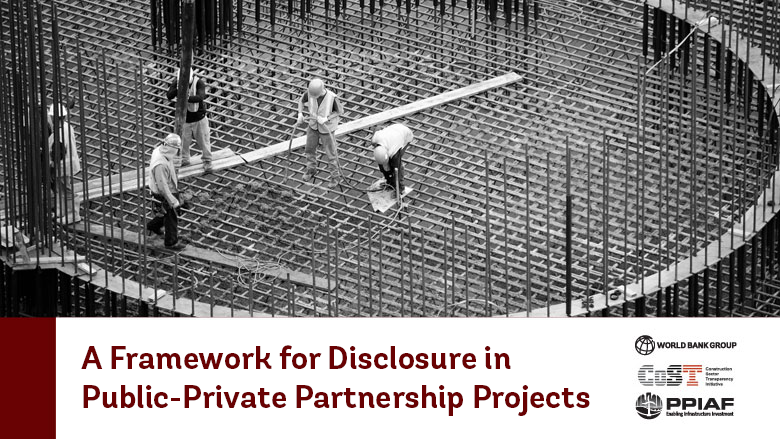Also available in: Español | Français | العربية

The consultation period deadline has been extended to February 29th 2016 at midnight EST. Thank you for your time and valuable input.
For too long, there has been a dearth of literature and guidance on policy and practice in public-private partnership (PPP) disclosure and a wide gap in understanding the mechanics of disclosure by practitioners within governments and the private sector. The just-released Framework for Disclosure in Public-Private Partnership Projects, a systematic structure for proactively disclosing information, fills this gap. Two additional documents, Jurisdictional Studies and Good Practice Cases, provide relevant background and resources, complementing the goals of the Framework.
Your input and PPP experience (locally, regionally and globally) are imperative to help us get this framework right. While the documents have been drafted, we are eager to incorporate feedback that will make them better. Please take a few minutes to read the documents and provide us with your input on this page to further refine this work.
Why focus on disclosure?
Disclosure and transparency are high priorities for successful public-private partnerships, which involve government officials and corporate leaders in high-stakes deals. PPP contracts, and the multi-million dollar financing agreements behind them, are powerful tools that governments can use to leverage private sector knowledge, experience, and financing capacity to improve the volume and quality of basic services provided to local populations.
Many successful PPPs have a high level of transparency during the procurement phase, but so far there’s been no widely-accepted framework for the sort of disclosure process that a PPP should follow during the pre- and post-procurement phases, and very little written about guidelines for transparent PPPs that would apply to the majority of these deals – which are growing in number around the world.
The Framework outlines a new way forward. It has been designed based on the key drivers of disclosure, major factors influencing the drivers, the challenges and benefits, the uses and various categories of users of information and risk sharing mechanisms within contracts. With this Framework in place, data that’s critical to the success of a PPP while it is still in progress, and data that is important to factor into planning for future PPPs, can be generated and standardized for the benefit of infrastructure partnerships worldwide.
The World Bank Group’s consultations with stakeholders suggests that there are multiple interconnected key drivers, such as a desire to mobilize private capital for investment, increasing public confidence in projects, achieving better value for money and reducing the risk of corruption. Key issues underlying these are extent of alignment of private investments with public interest, standards in the delivery of services, predictability around pipelines, a level playing field for bidders and objective criteria for evaluating bids, among others.
More direct factors appear to be the wider government policy on transparency and whether there is supportive legislation. An inference that can be drawn is that good practice may be associated with the existence of legislation supporting disclosure, identified as Freedom of Information or Public-Private Partnerships, Public Financial Management, sector specific and/or budget transparency legislation. Where legislation mandates proactive disclosure, more information seems to be available in the public domain. Another inference is that practice relating to PPP disclosure may have developed more rapidly in emerging countries because of an imperative to create new infrastructure.
The Framework is recommended for use by jurisdictions with existing or potential PPP programs with suitable customization based on maturity of program, current status of disclosure, types of contract structures and payment mechanisms used, and public sector capacity.
We look forward to your feedback!
Related: Check out the latest issue of our Handshake magazine on disclosure



Join the Conversation